
Run, runner! In 1976, one of the greatest science fiction novels of 1967 became one of the most important sci-fi movies of the 1970s. Logan’s Run is a strange confluence of science fiction traditions that altered its source material enough to actually eclipse the book, and its strange origins make it one of the most misunderstood sci-fi films ever.
When Logan’s Run hit theaters, fans familiar with the slim novel by William F. Nolan and George Clayton Johnson were presumably pumped. But how many of those people were there? Although genre aficionados considered the novel wonderful, it wasn’t nominated for a Hugo or a Nebula. And though Nolan and Johnson had some serious sci-fi cred (the latter wrote the first episode of Star Trek to air), the movie soon supplanted their book.
Although it was published in the same era as Frank Herbert’s Dune and Philip K. Dick’s Do Androids Dream of Electric Sheep?, the novel isn’t spoken about in the same reverent tones relative to its movie adaptation. The number of people who have seen Logan’s Run may not be huge, but the number who still read the book must be minuscule. There are several ways to explain this, the most tempting of which would be to argue that the movie is simply better. But that’s not it.
Both the novel and the film float a similar dystopian premise about futuristic population control. There’s an age where people are required to die, those who try to skirt this rule are called “runners,” and they’re hunted by people called Sandmen. In the movie, the age of “renewal” is 30. In the novel, it’s just 21, a stark difference that makes the novel weirder and hard to buy. But the motivation was clear: the book represents a kind of twisted Lord of the Flies endgame. What if all the college kids protesting in the ‘60s really did run the world?
The novel is a bit more subtle than that, but this central premise is largely why it hasn’t aged well. Which is a shame because, unlike the movie, the world-building is expansive. In the film, Logan (Michael York), Jessica (Jenny Agutter), and all the other twenty-somethings live in domed cities, where the outside world is a distant memory. So when Logan and Jessica escape the domes, they’re out in the wilderness and we’re in Planet of the Apes territory, in which familiar buildings like the Capitol have been overrun by vines and cats.
These features make Logan’s Run the quintessential dystopia, more reminiscent of Brave New World than its own source material. In fact, if the underrated 2020 TV version of Brave New World reminds you of Logan’s Run, there’s a reason for that. The idea of splitting the action between the city and the wilderness is a classic sci-fi trope, but in the book, Logan and Jessica crisscross North America before winding up on a space colony near Mars.

The film, smartly, keeps things more grounded. In the book, the “Sanctuary” where Logan and Jessica can grow old in peace is out there in space. They escape their corrupt society rather than try to remake it. The movie is the opposite: there is no Sanctuary, so Logan and Jessica bring this revelation back to the domed cities and wake humanity up. This results in the film’s most famous line, “You don’t have to die at 30! You can live! LIVE!”
For this reason alone, Logan’s Run will live on as a movie rather than a book. In writing the screenplay, what David Zelag Goodman understood was something Johnson and Nolan overlooked. It’s not just about making the age limit more believable. At some point, Logan’s Run can’t just be about running away.
Logan’s Run leaves HBO Max on March 31.







